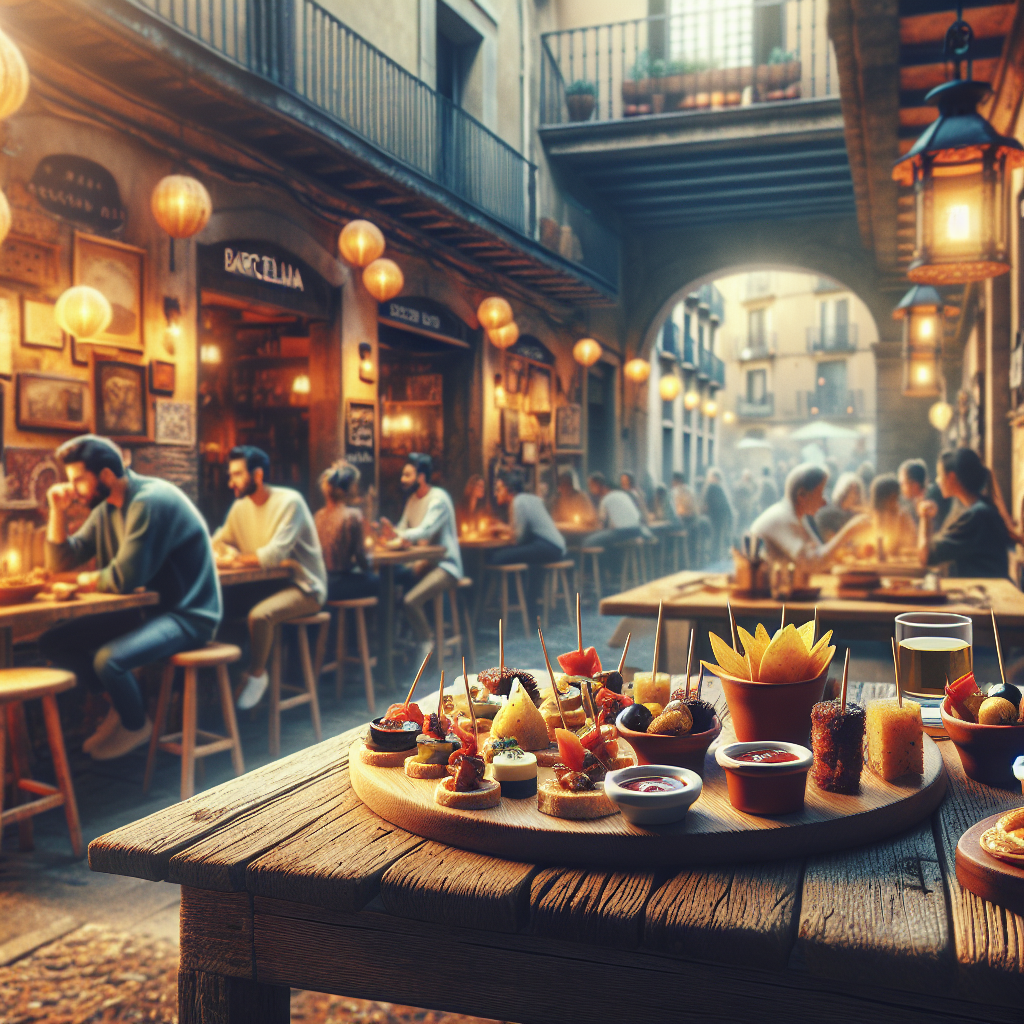The best authentic tapas in Barcelona can be found in traditional bars, markets and small taverns scattered across neighbourhoods such as the Barri Gòtic, El Born, Gràcia, the Eixample and Barceloneta; look for places with a bar lined with homemade dishes, a local crowd and a menu based on classics like patatas bravas, pa amb tomàquet and croquettes.
What we mean by authentic tapas
An authentic tapa in Barcelona isn’t just a snack: it’s an expression of local cooking, prepared with fresh ingredients, simple flavours and humble technique. Authentic tapas are often served at bars where neighbours and visitors share space, prioritising produce, tradition and friendly service. As experts who guide visitors and residents, at Cannabis in Barcelona we value authenticity: dishes cooked to order, family recipes and an atmosphere that makes you want to return.
Must-try dishes: what to order to sample the best
If your goal is to taste the best authentic tapas in Barcelona, there are a number of dishes you should try to understand the local food culture. Here’s a list with descriptions and why they’re representative:
- Pan con tomate (pa amb tomàquet): simple and essential—bread rubbed with ripe tomato, olive oil and salt. It pairs with almost any tapa.
- Patatas bravas: fried potatoes in chunks with a spicy sauce or alioli; a classic that varies from bar to bar.
- Croquettes: creamy inside and crisp outside; typical fillings include ham, chicken or salt cod.
- Bomba: a breaded, fried potato ball stuffed with meat and served with two sauces; very typical of Barceloneta.
- Calamares a la romana: lightly battered fried squid, ideal for sharing with a cold beer.
- Pimientos de Padrón: small green peppers, fried and salted—the fun is that some are spicy.
- Tortilla española: potato and onion omelette, either soft and runny or set, depending on the bar.
- Anchovies or boquerones: tinned or in vinegar, found on many bars and perfect with bread.
- Jamón ibérico: hand-sliced at the bar; a quality tapa that showcases the excellence of Spanish produce.
Neighbourhoods and markets with the best options
Barcelona offers a wide variety of settings in which to enjoy authentic tapas. Each neighbourhood adds its own character:
- Barri Gòtic: narrow streets and historic bars—ideal for traditional tapas after a stroll through the centre.
- El Born: a blend of tradition and modernity; you’ll find bars with classic offerings and contemporary takes.
- Gràcia: neighbourhood vibe, lots of small taverns with homemade tapas and local prices.
- Eixample: roomier cafés and taverns, perfect for group dinners and for those seeking variety.
- Barceloneta: by the sea, where seafood tapas and fried dishes stand out.
- Markets such as La Boqueria or Sant Antoni: stalls with fresh products and some bars inside or nearby serving top-quality tapas.
How to choose a good tapas bar
You don’t need to memorise which places are the “best”; learn to spot signs of quality. A good tapas bar typically shows these traits:
- Local clientele: if neighbours eat there daily, that’s a good sign.
- Dishes visible on the bar: tapas prepared in plain sight indicate freshness and tradition.
- Short, coherent menu: better a small, well-executed selection than too many poorly handled options.
- Solid versions of the basics: if the patatas bravas and tortilla are good, the rest probably are too.
- Staff who make recommendations: a server who knows the menu and suggests pairings inspires confidence.
Practical tips before you walk in
- Avoid overly touristy spots right in the centre if you want absolute authenticity; head a few streets away and you’ll notice the difference.
- Ask for small or half portions if you want to try several dishes without getting too full.
- Respect local customs: in many bars you pay at the end and share tables.
Drinks and pairings to go with tapas
Tapas are enjoyed as much for the drinks as for the food. Some classic, accessible pairings are:
- Vermouth: traditional for afternoon tapas—aromatic and perfect with tinned seafood and fried bites.
- Beer: a safe choice with fried dishes, squid and salty tapas.
- Cava or a young white wine: great with fish and seafood.
- Light red wines: complement cured meats and heartier dishes.
Tips for visitors and residents: how to make the most of it
The tapas experience is social and flexible. To get the most out of it, we recommend:
- Take your time: tapas are meant to be enjoyed unhurried. Book when necessary, especially at weekends.
- Share several dishes: that way you can try more flavours without filling up on a single portion.
- Ask about daily specials: many bars offer off-menu tapas made with fresh produce.
- Don’t be shy: local staff are usually happy to recommend their speciality.
Our experience and why you can trust us
At Cannabis in Barcelona we support visitors and residents from a local, practical perspective: we know the city, its neighbourhoods and the customs around its gastronomy. Although our main activity is facilitating access to cannabis social clubs and providing safe information, we also believe that understanding local culture—including its cuisine—enriches any visit. We share recommendations based on direct observation, conversations with residents and everyday experience eating at bars and markets across the city.
Common mistakes when searching for authentic tapas
To avoid disappointment, steer clear of these frequent errors:
- Relying solely on reviews that prioritise looks: many authentic places aren’t “Instagrammable” but serve better food.
- Assuming expensive is always better: Barcelona has excellent tapas at moderate prices in neighbourhood taverns.
- Not speaking to the staff: asking questions can lead you to off-menu dishes or local recommendations.
Summary
The best authentic tapas in Barcelona are discovered by trying classics at bars busy with locals, exploring neighbourhoods such as the Barri Gòtic, El Born, Gràcia, Eixample and Barceloneta, and visiting markets where great produce is the star. Prioritise places with visible dishes, a coherent menu and a welcoming atmosphere. At Cannabis in Barcelona we help you get to know the city with practical, safe suggestions so your food experience is memorable.
Frequently Asked Questions (FAQ)
Where can I find authentic tapas near the main tourist attractions?
There are plenty of options around tourist areas; for a more authentic experience, walk a few streets towards nearby residential neighbourhoods (for example, from the centre towards Gràcia or El Born) and look for bars with local clientele and dishes visible on the bar.
Is eating tapas in Barcelona expensive?
Prices vary by area and venue type. There are tapas for all budgets—from neighbourhood taverns with moderate prices to more sophisticated bars. Sharing several tapas is an economical, varied way to eat.
Do I need to book to go for tapas?
At peak times (weekend evenings) booking is advisable, especially if you’re in a group. For a bar-counter experience or eating in markets, reservations are usually unnecessary.
Can I find vegetarian and vegan options?
Yes. Many bars offer plant-based tapas such as Padrón peppers, mushrooms, escalivada or vegetable croquettes, and vegan options are increasingly common on both modern menus and adapted traditional ones.
What’s the difference between a tapa and a ración?
A tapa is a small portion meant for snacking or sharing, while a ración is a larger portion to share among several people. Ordering several tapas and one or two raciones is a good strategy for groups. If you need personalised recommendations based on your tastes, budget and location, at Cannabis in Barcelona we can guide you so you try the most authentic tapas and enjoy the local gastronomy like a resident.

